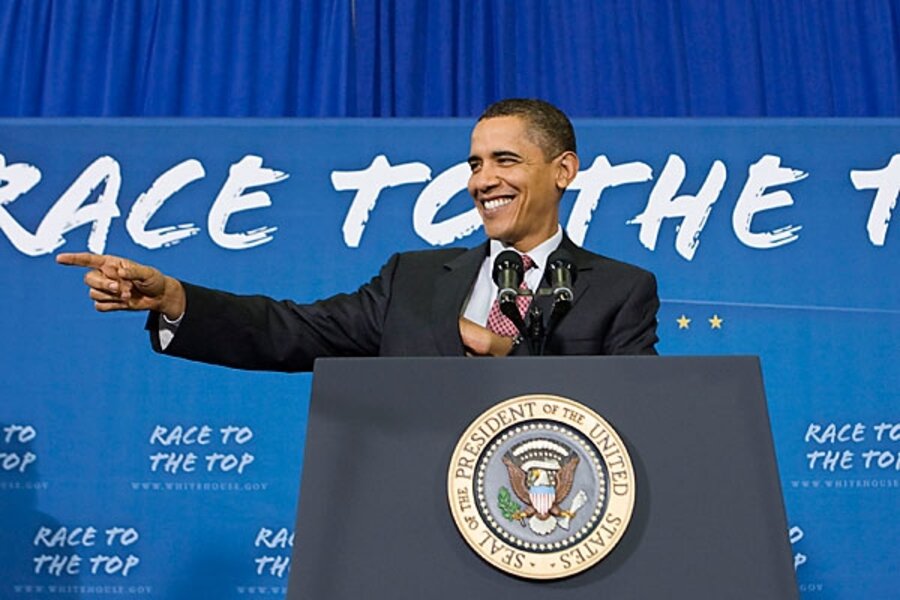Schools sprinting to win Obama's Race to the Top billions
Loading...
President Obama touted Race to the Top to the nation in a speech in Madison, Wis., Wednesday. But schools already know it well.
Mr. Obama's $4.35 billion in Race to the Top funds have already spurred significant education reform in a number of states – even though the final guidelines for the program haven’t yet been announced, no states have yet applied, and the first grants won’t be made until at least April.
The program offers competitive grants to states that have policies aligned with certain federal priorities. These priorities include a willingness to evaluate teachers using student achievement, an openness to charter schools, and a commitment to building long-term data systems to track student performance.
Now, numerous states are revisiting laws that would disqualify them from the grants or make their applications less attractive.
“The administration has done a good job of having a lot of states make a long-odds bet that they’re going to win Race to the Top funds, so they’ve shaped their behavior a lot in advance of a single dollar being awarded,” says Russ Whitehurst, director of the Brown Center on Education Policy and a senior fellow at the Brookings Institution. “Most of what the administration is going to get [in terms of reform] it will get before the competition is actually completed.”
Changes coming
Obama highlighted these changes Wednesday.
• Some states, including California, Indiana, and Wisconsin are taking steps to remove “firewall” laws that prohibit student achievement from being used to grade teacher performance.
• Four states – Illinois, Tennessee, Louisiana, and Delaware – have raised or lifted their caps on the number of charter schools they permit, and at least seven more are working to do so.
• Some of the 11 states that don’t yet allow charter schools are considering proposals to do so.
“We’re saying, if you’re committed to real change in the way you educate your kids; if you’re willing to hold yourselves more accountable; if you develop a strong plan to improve the quality of education in your state, we’ll offer you a grant to help make that plan a reality,” Obama said in his remarks.
A competition for prestige
In federal terms, the $4 billion in Race to the Top funds is relatively small – especially compared with the other $95 billion for education, also included in the stimulus package, which went to more traditional expenditures like saving teacher jobs.
But the innovative design has given the money an outsize influence, say analysts – the promise of extra funds and the prestige that comes with it spurring states to demonstrate that they’re worthy.
“This is very historic…. You’re looking at a fundamental redefining of the federal role,” says Joe Williams, executive director of Democrats for Education Reform. With the guidelines that the administration has set forward, he adds, “there’s an established criteria for what it means to be a reform-minded governor or an education leader… The prestige is proving almost as valuable as the money.”
Four key areas of reform
In its draft guidelines for the fund, released in July, the administration announced it would be focusing on four key areas:
• Enacting internationally benchmarked standards, and tying assessments to them.
• Attracting and retaining good teachers, including measures such as performance pay and achievement-based evaluation systems.
• Improving data collection and using it to drive instruction.
• Using effective turnaround approaches for failing schools.
The right reforms?
Mr. Whitehurst of the Brookings Institution applauds the general guidelines in the reform, though he questions some of the particulars.
“It’s been a mistake to ignore curriculum,” he says. Evidence suggests a high-quality curriculum can make enormous difference in student achievement, he adds.
Whitehurst also questions the decision to place so much emphasis on charter schools and on turning around failing schools, calling such strategies more “hopeful” than “evidence-based.”
Be that as it may, Secretary of Education Arne Duncan “today has more money at his disposal to bring about change than any secretary of education has ever had,” says Jack Jennings, director of the Center on Education Policy in Washington.
To Mr. Jennings, the priorities that Race to the Top emphasizes seem aligned with where school reform is headed.
“This is the next wave of school reform, and it’s eclipsing No Child Left Behind,” Jennings says. “The conversation has shifted to charter schools, data systems, tying pay to performance, and common standards. It’s as if we’ve moved on.”
See also:
Obama’s $4 billion is massive incentive for school reform
-----
Follow us on Twitter.





